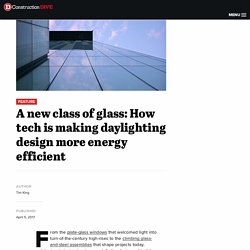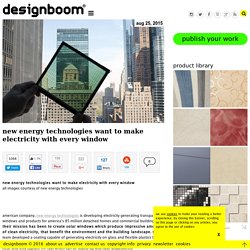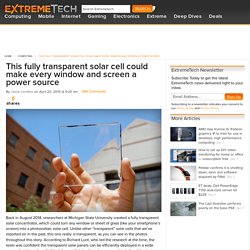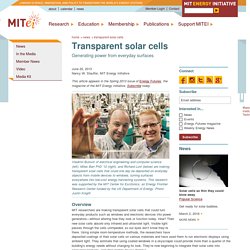

Crosscut - Scientists at University of Washington are... Phoenicia-ltd. Glassonweb. A new class of glass: How tech is making daylighting design more energy efficient. From the plate-glass windows that welcomed light into turn-of-the-century high-rises to the climbing glass-and-steel assemblies that shape projects today, architectural glazing has been a definitive feature of building design for more than a century.

The trend is prevalent in commercial and residential buildings, which increasingly prioritize glass for its ability to bring daylight inside. However, typical glazing systems — from single insulated glass units to full-on curtainwalls — tend to be less energy efficient than the surrounding wall system. Owners have long pushed back on large glazing applications for fear of reducing the assembly’s energy performance and raising the cost to heat and cool the building interior.
However, the emergence of more energy-efficient glazing, along with better lighting design software, is encouraging project teams, and their clients, to give glass another look. Daylighting as a passive design tool Chris Gorthy Preconstruction manager, DPR Construction. Onyx Solar - Integración Fotovoltaica En Edificios (BIPV) - Materiales De Construcción Fotovoltaicos - Vidrio Fotovoltaico Para Edificación.
Vivaldi Conservatories. Onyx Solar - Integración Fotovoltaica En Edificios (BIPV) - Materiales De Construcción Fotovoltaicos - Vidrio Fotovoltaico Para Edificación. SunGuard - SunGuard Advanced Architectural Glass - Low-E Glass Windows. New energy technologies want to make electricity with every window. Aug 25, 2015 new energy technologies want to make electricity with every window new energy technologies want to make electricity with every window all images courtesy of new energy technologies american company, new energy technologies is developing electricity generating transparent windows and products for america’s 85 million detached homes and commercial buildings. their mission has been to create solar windows which produce impressive amounts of clean electricity, that benefit the environment and the building landscape. the team developed a coating capable of generating electricity on glass and flexible plastics that is processed uniformly in different color tints. these polymer organic photovoltaic arrays are clear and only capture UV rays which can be scaled up and have unparalleled manufacturablilty. researchers view through electricity generating ‘solarwindow’ they are being developed in architecturally-neutral colors they can tint in custom colors.

BUILDING INTEGRATED PV. This fully transparent solar cell could make every window and screen a power source (updated) Back in August 2014, researchers at Michigan State University created a fully transparent solar concentrator, which could turn any window or sheet of glass (like your smartphone’s screen) into a photovoltaic solar cell.

Unlike other “transparent” solar cells that we’ve reported on in the past, this one really is transparent, as you can see in the photos throughout this story. According to Richard Lunt, who led the research at the time, the team was confident the transparent solar panels can be efficiently deployed in a wide range of settings, from “tall buildings with lots of windows or any kind of mobile device that demands high aesthetic quality like a phone or e-reader.” Now Ubiquitous Energy, an MIT startup we first reported on in 2013, is getting closer to bringing its transparent solar panels to market. Lunt cofounded the company and remains assistant professor of chemical engineering and materials science at Michigan State University. For more, read How do solar cells work? Beautiful and Innovative Solar Roof Tiles - Gardens All. Transparent solar cells. June 20, 2013Nancy W.

Stauffer, MIT Energy Initiative This article appears in the Spring 2013 issue of Energy Futures, the magazine of the MIT Energy Initiative. Subscribe today. Vladimir Bulović of electrical engineering and computer science (left), Miles Barr PhD ’12 (right), and Richard Lunt (below) are making transparent solar cells that could one day be deposited on everyday objects from mobile devices to windows, turning surfaces everywhere into low-cost energy-harvesting systems. This research was supported by the MIT Center for Excitonics, an Energy Frontier Research Center funded by the US Department of Energy. Overview MIT researchers are making transparent solar cells that could turn everyday products such as windows and electronic devices into power generators—without altering how they look or function today. Transparent Armor from NRL; Spinel Could Also Ruggedize Your Smart Phone. Imagine a glass window that's tough like armor, a camera lens that doesn't get scratched in a sand storm, or a smart phone that doesn't break when dropped.

Except it's not glass, it's a special ceramic called spinel {spin-ELL} that the U.S. Naval Research Laboratory (NRL) has been researching over the last 10 years. Dr. Jas Sanghera and colleagues at the U.S. Naval Research Laboratory (NRL) invented a new way of making transparent spinel. "Spinel is actually a mineral, it's magnesium aluminate," says Dr. As a more durable material, a thinner layer of spinel can give better performance than glass.
NRL invented a new way of making transparent spinel, using a hot press, called sintering. The sintering method also allows NRL to make optics in a number of shapes, "conformal with the surface of an airplane or UAV wing," depending on the shape of the press. NRL is also looking at spinel for the windows on lasers operating in maritime and other hostile environments.
What is spinel? The U.S.